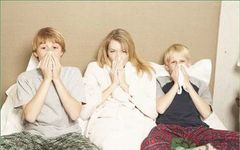 Grateful for Your Support Strengthening Awareness of Prevention and Control Treatment of Wind-Cold Common Cold
Grateful for Your Support Strengthening Awareness of Prevention and Control Treatment of Wind-Cold Common Cold
The typical symptoms of a Wind-Cold common cold include runny nose, cough, and sneezing, which can be quite uncomfortable. These symptoms are often due to a lack of proper warmth and can significantly affect daily life and work, necessitating timely treatment.
In Traditional Chinese Medicine (TCM), the external invasion of Wind-Cold is caused by the attack of Wind and Cold, leading to the failure of Lung Qi to disperse. Wind is a Yang pathogen that easily harms the head and facial orifices; Cold is a Yin pathogen that can damage Yang Qi. The combination of these two pathogens can obstruct the muscle layer, causing the pores to close, leading to a conflict between the pathogenic and the righteous Qi, resulting in this condition.Due to the predominance of Wind-Cold, there is often severe chills and mild fever; if the pores are closed, there will be no sweating; if the Taiyang meridian Qi is not smooth, there will be stiffness and pain in the head and neck, and body aches; if Lung Qi is not functioning properly, there will be nasal congestion with a heavy voice and clear phlegm cough.In clinical practice, TCM treatment for external Wind-Cold primarily involves warming and dispersing the exterior, as well as promoting Lung function and dispelling Cold, with dietary therapy based on these principles.
TCM Treatment Methods for Wind-Cold Common Cold
1. Herbal Decoctions: Gui Zhi Tang (Cinnamon Twig Decoction) is used to warm and disperse the exterior, and to promote Lung function and dispel Cold; its composition includes: Gui Zhi (Cinnamon Twig) 10g, Bai Shao (White Peony) 10g, Zhi Gan Cao (Honey-Fried Licorice) 6g, Sheng Jiang (Fresh Ginger) 3 slices, Hong Zao (Red Dates) 6 pieces. Jing Fang Bai Du San (Schizonepeta and Saposhnikovia Powder) can be modified, with the following ingredients: Jing Jie (Schizonepeta) 10g, Fang Feng (Siler) 10g, Sang Ye (Mulberry Leaf) 9g, Dou Chi (Fermented Soybean) 12g, Qiang Huo (Notopterygium) 10g, Qian Hu (Peucedanum) 6g, Chen Pi (Aged Tangerine Peel) 6g, Bo He (Peppermint) 6g (added at the end), Sheng Jiang (Fresh Ginger) 2 slices, Xing Ren (Apricot Kernel) 10g, Su Ye (Perilla Leaf) 9g, Jiao Zhi Qiao (Fried Bitter Orange Peel) 6g. Method: Decoction in water, take 1 dose daily, divided into 2 servings. Source: Shi Wenji’s formula.
2. Herbal Pills: Jiu Wei Qiang Huo Wan (Nine Flavor Notopterygium Pill), Shen Su Li Fei Wan (Ginseng and Perilla Lung Regulating Pill), Tong Xuan Li Fei Wan (Dispersing and Regulating Lung Pill).
3. Wind-Cold granules, common cold soft capsules, and common cold clearing heat granules. These medications all have the effects of dispersing the exterior, inducing sweating, dispelling Wind and Cold, and relieving cough.
Gua Sha Therapy: Scrape acupoints: Use a smooth hard object like a coin or a smooth stone dipped in white liquor to gently scrape the chest and back, as well as the popliteal fossa of the lower limbs, until the skin becomes red and warm. Then drink a bowl of hot ginger sugar water, and after about 15 minutes, you will sweat profusely. After sweating, the body feels relaxed and comfortable; at this time, be careful to avoid Wind and Cold, and the cold will recover quickly.
Western Medicine Treatment Methods for Wind-Cold Common Cold
Drug treatment: Western cold medications mainly consist of three types of ingredients: one type is antiviral medications, such as compound aminophenol and amantadine; the second type is symptomatic treatment medications, such as antipyretic and analgesic drugs like acetaminophen, which can relieve fever, body aches, and headaches; pseudoephedrine hydrochloride can relieve nasal mucosal congestion and swelling, treating nasal obstruction; antihistamines like chlorpheniramine maleate can reduce sneezing and tearing; dextromethorphan hydrobromide can relieve cough. The third type is antibiotics, mainly used for bacterial infections secondary to colds or flu, such as tonsillitis and bacterial pneumonia. Western prescriptions include: NyQuil, Tylenol, Ganmao Qingre, and Kangtai Ke. Choose one + antiviral medication, and take according to the instructions. Prescription note: The above medications have antipyretic and analgesic effects, reduce nasal mucosal congestion, suppress cough, and have antihistamine effects.
Causes of Wind-Cold Common Cold
1. Improper daily living habits: For instance, changing clothes or removing hats, seeking coolness by sleeping outdoors, frequently exposing oneself to electric fans or air conditioning, getting wet in the rain, or excessive fatigue without proper rest can lead to loose muscle layers, disharmony of the defensive and nutritive Qi, allowing external pathogens to invade.
2. Excessive fatigue, depleting physical strength: This can lead to the depletion of righteous Qi, loose muscle layers, and an inability to secure the exterior, making one susceptible to external pathogens.
Common Knowledge for Preventing Colds in Daily Life
Gargling with salt water: Gargle with diluted salt water every morning and evening, and after meals, to eliminate oral bacteria. During flu season, it is especially important to gargle with salt water; tilting the head back while gargling allows the salt water to thoroughly wash the throat for better effect.
Cold water face wash: When washing your face daily, use cold water, and scoop a handful of water to wash your nostrils, gently inhaling a small amount of water (be careful not to inhale too deeply to avoid choking) and then blowing your nose, repeating several times.
Hot water foot baths: Soak your feet in hot water (the temperature should be as hot as tolerable) for 15 minutes every night, ensuring the water covers the tops of your feet; after soaking, your feet should be red to help prevent colds.
Steam inhalation: At the onset of a cold, pour boiling water into a cup and take deep breaths over the steam until the water cools, several times a day, which can alleviate nasal congestion symptoms.
Hot air blowing on the face: At the onset of a cold, use a hairdryer to blow hot air on the temples for 3 to 5 minutes several times a day to reduce symptoms and speed recovery.
—END—
Edited by: Yang Juan
Copyright Statement: This public account is purely for public welfare. We focus on sharing, and some articles and images are sourced from the internet, with copyright belonging to the original authors. If there are any objections, please inform us, and we will delete them promptly.
Total Issue 881Issue
Stay Tuned


